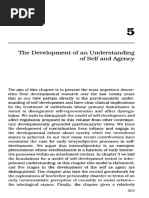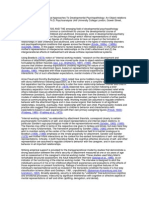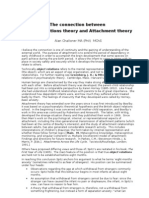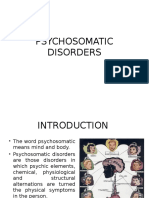Object Relations Theory
Uploaded by
Monika JosephObject Relations Theory
Uploaded by
Monika JosephObject relations theory Date of last revision September 2, 2011 Introduction
Object relations theory is a psychodynamic theory. Ronald Fairbairn coined the term "object relations and Melanie Klein is most commonly identified with the term "object relations theory" It describes the process of developing a mind as one grows in relation to others in the environment. The theory may be defined as a system of psychological explanation based on the premise that the mind comprises elements taken in from outside, primarily aspects of the functioning of other persons." The theory emphasizes interpersonal relations, primarily in the family and especially between mother and child. Major proponents are o Melanie Klein o D.W. Winnicott o Margaret Mahler
Major Concepts
Theory guides inner world exploration and recognizes the introjected persons of the past living within the patients mind, comprising the persons psychic structure (Mohl PC, 2008).
Introjects
Introjects refers to the internalized images of others within the patient. Focus of attention of the theory.
Objects
The "objects" of the theory are both real others in one's world, and one's internalized image of others. Objects are usually persons, parts of persons, or symbols of one of these.
Object relations
object relations refers to interpersonal relations or specific intrapsychic structures.
Representation
refers to the way the person has or possesses an object.
Psychological Positions
Klein explains two two psychological positions during the first year of life. o paranoidschizoid position - during the first 6 months of life o depressive position - during the second 6 months. Paranoidschizoid position is characterized by the defenses of projection, introjection, projective identifi cation, splitting, idealization, omnipotence, and denial. Depressive position is characterized by d epressive anxiety.
Implications to Nursing
The object relations theory helps understanding of children's behaviour and guides nursing practice. The theory provides conceptual model for practicing psychodynamic family.
Refrences 1. Psychiatry, Third Edition. Edrs. Allan Tasman, Jerald Kay, Jeffrey A. Lieberman, Michael B. First and Mario Maj.John Wiley & Sons, Ltd, 2008.
You might also like
- Handbook of Psychotherapy Integration 3nbsped 0190690461 9780190690465 CompressNo ratings yetHandbook of Psychotherapy Integration 3nbsped 0190690461 9780190690465 Compress545 pages
- Affect Regulation, Mentalization, and The Development of The Self (Peter Fonagy, Gyorgy Gergely, Elliot L. Jurist Etc.) - 211-259-1-25No ratings yetAffect Regulation, Mentalization, and The Development of The Self (Peter Fonagy, Gyorgy Gergely, Elliot L. Jurist Etc.) - 211-259-1-2525 pages
- Tuguinay, Joshua FLA5 Object Relations (Concept Map)No ratings yetTuguinay, Joshua FLA5 Object Relations (Concept Map)3 pages
- Object Relation Psychoanalytic Criticism On Selected Works of Tennessee Williams0% (1)Object Relation Psychoanalytic Criticism On Selected Works of Tennessee Williams25 pages
- The Analysis of the Self: A Systematic Approach to the Psychoanalytic Treatment of Narcissistic Personality DisordersFrom EverandThe Analysis of the Self: A Systematic Approach to the Psychoanalytic Treatment of Narcissistic Personality DisordersNo ratings yet
- Otto Kernbergs Object Relations Theory A MetapsycNo ratings yetOtto Kernbergs Object Relations Theory A Metapsyc26 pages
- Object Relations, Dependency, and Attachment: A Theoretical Review of The Infant-Mother Relationship100% (1)Object Relations, Dependency, and Attachment: A Theoretical Review of The Infant-Mother Relationship49 pages
- Tuguinay, Joshua FLA6 Later Views On Object Relations (Concept Map)No ratings yetTuguinay, Joshua FLA6 Later Views On Object Relations (Concept Map)1 page
- Kernberg - An Integrated Theory of DepressionNo ratings yetKernberg - An Integrated Theory of Depression6 pages
- Integrating Object Relations and Alcoholics Anonymous Principles in The Treatment of Schizoid Personality DisorderNo ratings yetIntegrating Object Relations and Alcoholics Anonymous Principles in The Treatment of Schizoid Personality Disorder16 pages
- Psychodynamic Therapy Techniques: A Guide To Expressive and Supportive Interventions Brian A Sharpless 2024 Scribd Download100% (4)Psychodynamic Therapy Techniques: A Guide To Expressive and Supportive Interventions Brian A Sharpless 2024 Scribd Download62 pages
- The Psychodynamic Diagnostic Manual Vers PDF100% (1)The Psychodynamic Diagnostic Manual Vers PDF22 pages
- Classical Psychoanalisis Ego Psychology - NotesNo ratings yetClassical Psychoanalisis Ego Psychology - Notes6 pages
- The Psychodynamic Formulation - Its Purpose, Structure and Clinical Application-2006No ratings yetThe Psychodynamic Formulation - Its Purpose, Structure and Clinical Application-20069 pages
- Fonagy - Psychoanalytic and Empirical Approaches To Developmental Psychopathology An Object-Relations PerspectiveNo ratings yetFonagy - Psychoanalytic and Empirical Approaches To Developmental Psychopathology An Object-Relations Perspective9 pages
- HEINZ KOHUT (1913-1981) : 2221 Theory & Practice 1: Lecture 7No ratings yetHEINZ KOHUT (1913-1981) : 2221 Theory & Practice 1: Lecture 710 pages
- Wallin 2007 How Attachment Relationships Shape The SelfNo ratings yetWallin 2007 How Attachment Relationships Shape The Self9 pages
- Briggs - Time Limited Psychodynaic Psychotherapy For Adolescents and Young AdultsNo ratings yetBriggs - Time Limited Psychodynaic Psychotherapy For Adolescents and Young Adults16 pages
- Download full Psychodynamic Treatment of Depression 2nd ed 1st Edition Fredric N. Busch ebook all chapters100% (2)Download full Psychodynamic Treatment of Depression 2nd ed 1st Edition Fredric N. Busch ebook all chapters62 pages
- 3 Affect Regulation, Mentalization, and The Development of The Self (Peter Fonagy, Gyorgy Gergely, Elliot L. Jurist Etc.) - 211-259No ratings yet3 Affect Regulation, Mentalization, and The Development of The Self (Peter Fonagy, Gyorgy Gergely, Elliot L. Jurist Etc.) - 211-25949 pages
- Connection Between Object Relations Theory and Attachment Theory50% (6)Connection Between Object Relations Theory and Attachment Theory2 pages
- Casebook of Interpersonal Psychotherapy 1st Edition John C. Markowitz all chapter instant download100% (6)Casebook of Interpersonal Psychotherapy 1st Edition John C. Markowitz all chapter instant download71 pages
- Malcolm Pines - The Group-As-A-whole Approach in Foulksian Group Analytic PsychotherapyNo ratings yetMalcolm Pines - The Group-As-A-whole Approach in Foulksian Group Analytic Psychotherapy5 pages
- Multiple Personality Disorder - A Case Report From Northern IndiaNo ratings yetMultiple Personality Disorder - A Case Report From Northern India4 pages
- 'SelfObject' Needs in Kohut's Self Psychology0% (1)'SelfObject' Needs in Kohut's Self Psychology37 pages
- Ebooks File Manual of Panic Focused Psychodynamic Psychotherapy Extended Range 1st Edition Fredric N. Busch All Chapters100% (2)Ebooks File Manual of Panic Focused Psychodynamic Psychotherapy Extended Range 1st Edition Fredric N. Busch All Chapters84 pages
- Preserving The Person in Contemporary Psychiatry: Glen O. GabbardNo ratings yetPreserving The Person in Contemporary Psychiatry: Glen O. Gabbard9 pages
- Psychoanalytic Supervision Group, IndianapolisNo ratings yetPsychoanalytic Supervision Group, Indianapolis1 page
- Eugen Bleuler's Dementia Praecox or TH Group of SchizophreniasNo ratings yetEugen Bleuler's Dementia Praecox or TH Group of Schizophrenias9 pages
- Puerperium Women and Mental Health - SIM Final80% (5)Puerperium Women and Mental Health - SIM Final72 pages
- Unit-I: Characteristics & Structure of GenesNo ratings yetUnit-I: Characteristics & Structure of Genes64 pages























































































